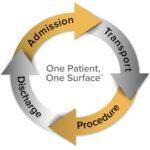
As AI continues to make waves across the healthcare industry, surgical centers are no exception. From enhancing operational efficiency to improving surgical outcomes, AI offers transformative potential for surgical procedures. However, there’s an underlying challenge: the IT gaps that could hinder your center’s ability to fully leverage AI-powered tools and solutions.
We understand the importance of integrating technology into your surgical environment. Whether it’s optimizing staff workflows, enhancing patient outcomes, or streamlining administrative tasks, AI has the potential to reshape how surgery centers operate. But to take full advantage of these advancements, addressing IT readiness is critical.
The Rise of AI in Surgical Procedures
AI is poised to revolutionize surgery centers in numerous ways. From predictive analytics that help manage surgical scheduling and staffing needs, to AI-assisted robotic surgeries, the opportunities are vast.

AI can improve surgical precision, reduce human error, and even predict patient recovery times based on historical data. However, for these innovations to be successfully implemented in surgical environments, surgery centers need a strong IT foundation to integrate these technologies seamlessly.
Sign up to get the latest industry news and offers right in your inbox
IT Talent Gaps: The Hidden Barrier
Despite the promise of AI, many surgery centers are facing significant IT talent gaps. As surgical centers adopt more complex technologies, the need for specialized IT professionals grows.
Clinical IT experts—those with the skills to assess, implement, and manage AI technologies in the operating room—are in high demand, yet in short supply. Without the necessary IT staff, your surgery center risks falling behind on adopting the latest AI tools or, worse, implementing them in a way that could compromise patient care and safety.
Given that AI technology is evolving rapidly, many surgery centers may find themselves unable to keep up with new capabilities, such as predictive analytics for surgical outcomes or AI-powered tools for real-time patient monitoring during procedures.
The Risks of Not Addressing IT Gaps
AI technologies are only as effective as the systems that support them. Without adequate IT talent and infrastructure, there are significant risks associated with integrating AI into surgical workflows.
Poor governance, lack of monitoring, and security vulnerabilities are all potential consequences of trying to deploy AI without the proper IT support. Additionally, without proper training and coordination between IT and clinical teams, AI tools may not be optimized for real-world surgical environments, leading to inefficiencies and potential errors.
Governance committees must ensure AI solutions are tested and evaluated before they are fully integrated. Stress testing these technologies is essential for identifying vulnerabilities that could negatively impact the quality of care during procedures. With the rapid pace of AI innovation, surgery centers must be prepared to evaluate, monitor, and adjust AI tools as new capabilities are introduced.

Building IT Readiness for AI in Surgical Settings
To fully embrace AI’s potential, surgery centers must first address their IT readiness. Here’s how:
- Invest in IT Talent: Ensure your surgery center has the right mix of IT professionals with expertise in AI tools and systems. Training existing staff and hiring specialized roles can provide the support needed to manage AI technologies effectively.
- Establish a Governance Framework: Implement committees focused on AI oversight to ensure technologies are evaluated, stress-tested, and integrated safely into surgical workflows. This will help prevent data breaches and reduce the risk of AI malfunctions during surgeries.
- Foster Collaboration: Promote collaboration between IT professionals and surgical teams to ensure that AI tools meet the specific needs of your surgical procedures. Regularly communicate to optimize AI tools and ensure they support both clinical goals and operational efficiency.
- Adapt to New Innovations Gradually: Don’t rush the AI adoption process. Deploy AI solutions in phases, allowing time for adjustments and feedback from clinical and IT teams.
- Ensure Continuous Training: Provide ongoing training for both IT staff and clinicians to ensure everyone is equipped to work with the latest AI tools as they are integrated into surgical environments.
Supporting Surgical Teams with the Right Medical Seating
 While IT gaps and AI readiness are critical considerations for surgery centers, it’s equally important to ensure that the physical environment supports these technological advancements. Procedure chairs are a key example of how surgery centers can optimize the patient experience and enhance clinical workflows.
While IT gaps and AI readiness are critical considerations for surgery centers, it’s equally important to ensure that the physical environment supports these technological advancements. Procedure chairs are a key example of how surgery centers can optimize the patient experience and enhance clinical workflows.
Champion’s Procedure Chairs are expertly designed to meet the demands of surgery centers, offering exceptional comfort and flexibility for both patients and clinical teams.
Each patient remains on one surface throughout their visit—comfort, safety, efficiency, and functionality combined! One piece of equipment also means you save time, money, and space. Invest in a procedure chair that puts patients first and affords precise positioning for surgeons, easy access for caregivers, and smoother transport for medical staff.
Meet Champion’s T5 Procedure Chair from our popular T-Series! Our redesigned T5 offers even more clinical and economic advantages to doctors and patients.
From the new sleek color to the new battery to the new triple column base—we’ve taken a successful procedure chair and made it even better.
Commonly used in Ophthalmology and neck-up Plastic Surgery settings, the T5 enables medical facilities to streamline the treatment process and surgical flow by replacing multiple pieces of equipment with a single device. This innovative procedure chair helps minimize risk, maximize space, and increase productivity.
Preparing for the Future of Surgery with AI and IT Readiness
AI has the potential to redefine how surgical procedures are planned, performed, and managed, but surgery centers must be proactive in addressing IT gaps and fostering collaboration between clinical and IT teams. By ensuring your center is IT-ready, you can harness the power of AI to improve surgical outcomes, streamline operations, and ultimately provide better care for your patients.
At Champion, we believe that technology and tools go hand in hand. As you prepare for the future of AI in surgical settings, investing in both IT infrastructure and ergonomic solutions—like our innovative procedure chairs—will ensure your surgery center is ready to meet the challenges and opportunities that lie ahead.
To view Champion’s entire portfolio of products, browse our digital catalog. Then, request a quote for your facility.
